15 Creative Examples of Fast Food Packaging (Both Real and Imagined)
Sometimes the packaging is even better than the food.
2023-09-10 22:50
10 Facts You Might Not Know About Red Robin
It was named for the song.
2023-09-10 20:59

Onam harvest festival keeps on getting bigger
Home cooked vegetarian food prepared by ten families, will be on offer at the vibrant event.
2023-09-09 13:56

What are Blue Zones and how do they impact your health?
The secret to living a longer life isn’t found in some elixir or fountain of youth. Rather, it’s said to be found in Blue Zones. Blue Zones are the five regions in the world where people are known to live long, healthy lives. These areas are Okinawa, Japan; Sardinia, Italy; Nicoya, Costa Rica; Ikaria, Greece and Loma Linda, California. Here, the foods people eat aren’t just part of some diet - it’s a way of life. The term Blue Zone was popularised by Dan Buettner, a National Geographic journalist who travelled the world studying the cultures of these thriving communities. In a 2020 master class hosted by the Global Wellness Summit, Buettner shared the foundation of living in a Blue Zone: “The big epiphany of all these Blue Zones is that long-lasting health is very rarely successfully pursued; it ensues.” Now, not everyone can pack their bags and whisk themselves off to Italy, but there are many ways to adapt your daily routine to the Blue Zone lifestyle. Here’s what we can learn from these regions: Fibre, fibre, fibre Foods rich in fibre are prominently featured in the diets of those living in a Blue Zone. Beans and whole grains like brown rice and quinoa are high-fibre ingredients that can lengthen your life. Fruits, vegetables, and legumes are also natural sources of fibre. Fibre plays a key role in promoting gut health, managing your weight, and reducing cholesterol levels. Research shows that children and adults need at least 20 to 30 grams of fibre per day, but most Americans get only about 15 grams a day. Whether it’s garbanzo beans in Greek hummus to black beans in Costa Rican soup, increasing your fibre intake is key to living a longer life. Move naturally You don’t need to work out at the gym five times a week to increase your longevity. In fact, residents in Blue Zone areas rarely workout at all, as their exercise mostly comes from activities done throughout the day, such as walking and gardening. Incorporating 20 minutes of movement in your daily routine is just one way to live the Blue Zone lifestyle. Maintain a positive outlook On average, Americans spend nearly five to six hours on their phones a day, from the moment they wake up to the moment they go to bed. Instead, begin your daily routine with a positive meditation, or separate the work day with mini stress breaks. In Blue Zones, residents shed their stress by engaging in sacred daily rituals, such as remembering their ancestors in Okinawa or taking naps in Costa Rica. Or, do like the Sardinians do: happy hour. Connect with others Curating a social circle is one of the main pillars of living in a Blue Zone. In an era of Zoom calls and work from home, connecting with those around us has proven to be a little more difficult than in years past. Even if it’s just a small group, engaging with others who keep you active, eat a similar high-fibre diet, and care about you on a bad day can help you live until you’re 100. Read More 11 best healthy food subscription boxes delivered right to your door 10 best exercise bikes for smashing your fitness goals at home Five waste-free recipes to take your Veganuary up a notch What are Blue Zones and how do they impact your health? Three healthy recipes to get back on track after summer Best burgers in London: Where to eat top patties in the city
2023-09-09 03:16
U.S. food companies go deal hunting as pandemic growth fades
By Deborah Mary Sophia U.S. packaged food companies are set for a flurry of deals in a push
2023-09-08 21:51
World food price index back at two-year low despite rice surge -FAO
PARIS (Reuters) -The United Nations food agency's world price index fell in August to a new two-year low, reversing a
2023-09-08 16:52

Three healthy recipes to get back on track after summer
With September often thought of as a second January, it’s the perfect time to set goals and form new habits. Meal prepping is a great way to help you stay on track and reach your goals. Benefits include helping you to stick to healthier foods, saving money, minimising food waste, saving time and reducing stress. Sophie Dillon, head of nutrition at Fresh Fitness Food, has put together a few nutritious recipes (breakfast, lunch and dinner) that take less than 30 minutes to prepare and cook. Yoghurt and granola with berries Greek yoghurt is a great source of protein, and can also be beneficial for your gut, as it is a food-sourced probiotic (so long as it’s labelled to contain live cultures), and this homemade granola recipe is packed with slow-release carbs, providing a sustained energy release for your morning, and to help keep your blood sugar levels more stable. Tip: Batch-cook your granola and store in an airtight container for ease and an on-demand, nutritious addition to your yoghurts, smoothies, or if you just fancy a simple carby snack. Serves: 2 Time: 25 mins the first time, 5 mins once you have the granola on hand Ingredients: Handful of berries of your choice ½ cup ricotta cheese ½ cup Greek yoghurt ½ vanilla pod 1 scoop of vanilla whey For the granola: 50g buckwheat groats 100g oats 20g maple syrup 5ml olive oil ½ tsp ground ginger Method: 1. Blend the ricotta cheese till smooth and then mix in the Greek yoghurt, vanilla pod and whey protein. 2. Preheat the oven to 170C. 3. Place all ingredients for the granola into a bowl and thoroughly mix together. 4. Line a baking tray with some grease-proof paper, pour the granola mix onto the tray and pop in the oven for 10 minutes. 5. After 10 minutes, remove the tray and mix around the granola to break up any large clumps. 6. Place back into the oven for a further 10 minutes, then take out to cool. 7. Place the yoghurt in a bowl and top with granola and the berries of your choice. Bang bang chicken stir-fry Quick, easy meals are key when it comes to nailing your fitness goals, and this stir-fry is an easy lunchtime winner. We’d recommend cooking an extra couple of portions and popping them in the freezer for an easy dinner on busy days. Tip: If you end up with extra chicken, put it to the side to have in a bang-bang chicken salad. Serves: 2 Time: 15 mins Ingredients: 2 chicken breasts, cut into strips ½ juice of a lime 1 tbsp peanut butter ½ tsp tamari sauce ½ tbsp sriracha ½ carrot, julienne or grated ½ red pepper, sliced 1 spring onion, sliced 1 tbsp oil of choice (we recommend sesame for a nice, nutty flavour) 3 nests rice noodles ½ tbsp sesame seeds (optional) ½ red chilli, sliced and de-seeded (optional) Method: 1. Mix together the sriracha, lime, salt, lime, peanut butter and tamari thoroughly with a whisk. 2. Mix all ingredients together so the chicken is well coated 3. Heat the sesame oil in a wok. Once hot, add the chicken to the pan, and cook until golden. 4. While the chicken is cooking, cook your noodles per the instructions on the packet, and leave to stand for one minute before adding to your pan. 5. At the same time, add your carrots and red pepper and stir until everything is coated in the sauce/oil mixture. 6. Once the chicken is cooked and the veg is soft, mix in your spring onions, and plate up. 7. Garnish with sesame seeds and chilli, if desired. Crispy tofu poke bowl Tofu is a great source of plant-based protein, containing all the essential amino acids your body needs. It’s also rich in vitamins and minerals, including calcium, iron and vitamin A. The great thing about crispy tofu, aside from its nutritional benefits, is that it works just as well in leftovers, too. Throw it in a tofu satay curry, pad thai or into a salad for a plant-based protein boost. Serves: 2 Time: 30 mins Ingredients: 1 block of firm tofu 1 tbsp olive oil ½ tsp smoked paprika 1 tsp cornflour ½ carrot 100g cucumber 50g edamame 50g peas 150g uncooked rice 100g tenderstem broccoli 1 tbsp sesame seeds (optional) 1 nori sheet, sliced into strips (optional) Salt to taste Method: 1. Drain the tofu and cut into equal-sized pieces. 2. Mix the tofu with cornflour, salt, olive oil, smoked paprika, and tofu together. 3. Roast on lined trays at 190C until brown and crispy – around 20 mins. Drain once cooked. 4. While the tofu is cooking, cook your rice as per the instructions. 5. In the meantime, prepare your veg. Chop and de-seed your cucumber. 6. Steam your tenderstem, peas and edamame. 7. Once your tofu is crispy and your rice is cooked and drained, plate everything up, and garnish with the nori and sesame seeds. Read More Is bottomless prosecco going to be killed off by climate change? Budget Bites: Three ways to pimp up university student classics Epicurus: American fast food meets the Middle East in Camden Market ‘How being thrifty in the kitchen helped me get on the housing ladder’ How to make spinach and mushroom quiche For a quick sugar fix, try this Biscoff microwave mug cake
2023-09-08 16:48

Is bottomless prosecco going to be killed off by climate change?
Picture this. The group chat has finally settled on a date and we are going out. Out out. Women of most ages know how serious this is. There was probably a spreadsheet involved. Boyfriends and husbands have been dispatched to the pub. Children and dogs have been dropped off at the sitter. Dignity has been left at the door. One of us is waiting for it to be cancelled so we can stay at home with our loungewear and girl dinners (it’s probably me). There’s only one thing for it. Bottomless brunch. Many Asos orders and outfit changes later, we arrive, take our seats and start the binge drinking timer. There’s only one problem. No prosecco. Freshly manicured fists pound the table. The elected Karen of the group starts to verbally pulverise the staff. Eggs Benedicts are thrown against the walls. The Prosecco Huns exclaim in unison: “But what are we going to drink now?!” The waiter bashfully suggests: “Spumante?” Give over. According to a new study, this could be a reality in the near future thanks to climate change threatening vineyards across Europe, in particular those dedicated to glera (the beloved prosecco grape) in Northern Italy. In a detailed report in iScience last month, researchers warned that unpredictable weather, soil degradation and drought could lead to the loss of a millennia-old winemaking tradition, and the livelihoods attached to it. RIP the Prosecco Hun. The Italian sparkling wine has long been the fizz of choice in the UK (we were only dethroned as the world’s biggest prosecco guzzlers last year by the US). In the early 2010s, more than a third of all the prosecco shipped out of Italy worldwide ended up in Britain – approximately 131 million bottles a year. That’s nearly two bottles per Brit. You get the idea. The origin of our obsession with prosecco dates back to just after the 2008 crash, when consumers were looking for an alternative to expensive champagne. The softer tasting, far more affordable (thanks to its cheaper and speedier production time) and incredibly quaffable prosecco was the obvious choice. Bottomless brunch was born. “My heart goes out to the huns whose weekends simply aren’t complete without a bottle of prosecco,” Hannah Crosbie, founder of Dalston Wine Club, laments at the news that just 15 years after it stormed onto supermarket shelves, prosecco might be quietly forced to say arrivederci. “In all seriousness though, climate change is seriously threatening every aspect of winemaking, and growing conditions are only getting more challenging.” Prosecco is certainly not the only vino at risk, but it faces a unique issue. Where other wine growing regions affected by climate change such as Champagne and Burgundy can simply put out a limited run with an inflated price tag and keep the snobby oenophiles coming, prosecco’s USP is its ability to produce in bulk and at a fraction of the cost. English sparkling is a big winner with the climate going the way it is. Prosecco, by all accounts, seems like it’s a bit of a loser in that regard Will Amherst, head wine buyer at Trullo Ali Finch, group sommelier at Angela Hartnett’s Michelin-starred Italian restaurant Murano in Mayfair, doesn’t believe there’s an appetite for a higher quality, more expensive prosecco. “With the impact of the climate as well as the cost of producing wine increasing, the challenge for prosecco is going to be how to balance the expectation of its price point with the need to make slightly smaller quantities,” she tells me. “Regions like Chablis, for instance, have had multiple horrible vintages back to back and people just accept the fact they have to pay more for it if they want to drink that wine.” For the uninitiated, the word “vintage” on a wine label simply means the year the grapes were harvested – compared to regular wines that may include grapes harvested in multiple years – and each vintage can taste vastly different based on the conditions affecting the grapes in that year. Chablis, produced from chardonnay grapes in the northernmost district of Burgundy, has always been particularly affected by the climate due to its geography, but in recent years has seen frost in 2016, 2017 and 2021, and drought and higher temperatures in 2019 and 2020. This has dramatically affected those vintages, and driven up the price of bottles from “good” years. But with prosecco, “people potentially wouldn’t be interested in” paying a higher price, Finch says. This is partly because its brand has become more associated with cheap fizz than fine wine in Britain. Part of the problem also lies in the simplicity of its production. Prosecco is a wine that reflects the aromatics of the grape at the point of harvest, whereas with other sparkling wines like champagne, as well as other types of wine in general, such as chablis, it’s about the ageing process. Rising temperatures mean grapes are ripening more quickly, which can result in a different flavour of wine or too much alcohol, so one option is to harvest the grapes earlier. You can get away with a slightly under-ripe fruit in aged wines as so much of the flavour is added during their long fermentations. In prosecco, a bottle of which is ready in just 30 days, an under-ripe grape could result in something that “tastes a lot like battery acid”, according to Finch. The Prosecco Huns don’t want to chug something flavourless and eye-wateringly alcoholic with their eggs Benedict. “If you pick too early, you’ve got no flavour,” Finch explains. “So they don’t really have the option to just keep making it in the same volume. With other wines, you can do more work in the winery to make the wine feel more balanced and more approachable and more complex. They don’t have that luxury in prosecco.” Under Italy’s DOC (Denominazione di Origine Controllata) laws, prosecco is only prosecco when it comes from just two regions of the country, Veneto and Friuli-Venezia Giulia, and adheres to strict growing and production rules. The same goes for champagne: only wine produced from eight permitted varieties of grape grown exclusively in the Champagne region of France may be called champagne. It’s these “heroic viticulture” sites that the report says are most at risk. Naming rights have been a point of contention across the whole wine industry for some time, with Australian producers of glera recently putting in a request to the EU to be allowed to call their wine prosecco on the grounds that it’s part of their migrant and cultural identity. Ironically, the glera grape is actually believed to be Slovenian in origin, and was first cultivated in the vineyards of Prosecco, a small village in the Friuli-Venezia Giulia region near the border with Slovenia. The name is even thought to derive from the Slovenian words preseka or poseka, or the Serbian/Croatian prosek, meaning “path cut through the woods”. While DOC laws might prevent anyone calling a sparkling wine made from glera grapes outside of the designated regions a prosecco, it hasn’t stopped winemakers around the world from essentially producing the same wine using the same techniques. As climate change has made it increasingly difficult to cultivate the grapes in their historical home, it’s also made conditions in more northern regions like the UK more favourable for the growing of certain grapes, including white varieties such as glera, opening the door to a whole new generation of winemakers. “This is not me saying this is the death of prosecco,” Finch adds quickly, but she stresses that the wine industry is naturally very dynamic. “There are loads of alternatives to prosecco, both within Europe in terms of pet nats and cremants and things like that, and with the New World as well.” Pet nats – sparkling wines made using the “traditional method” of fermenting in individual bottles – have become very trendy among the younger Gen Z crowd, she says, as it still offers something bright, fruity and super fizzy, but without the faff, or price tag, that comes with champagne. People are also drinking less but are happy to spend a little more and not drink as much. At Murano, Finch says diners are asking about English sparkling wines more than ever before. “The correlation, obviously, with post-Brexit is there. There’s a desire to try and drink more local wines, potentially from a sustainability point of view, potentially from a cost-to-quality point of view because of duty increasing. It’s also partly because during Covid people did a lot of staycations and UK wine tourism did very well during that time. And it sort of stuck.” It’s a sentiment echoed by Will Amherst, head wine buyer at Italian trattoria Trullo in Islington, north London. “I don’t want to bash prosecco too much, but if I was going out and I wanted sparkling wine, I would still look at champagne,” he says, much to the chagrin of the Prosecco Huns. “And if I’m going to look somewhere other than that, I would get a bottle of English sparkling. Because English sparkling is a big winner with the climate going the way it is. Prosecco, by all accounts, seems like it’s a bit of a loser in that regard.” Prosecco and the people that produce it are certainly not the only losers but its high-altitude, cooler temperature geography, which previously protected it from climate change, is now adversely affected by extreme weather. Sudden, intense rainfall damages the soil and creates “slope failures”, while conversely droughts make irrigation extremely difficult. While he’s yet to see a knock-on effect on prosecco supplies at Trullo, Amherst’s “immediate thoughts were, really sadly: is prosecco going to be able to pull itself out of that hole? I don’t know how you reconcile the spiralling production costs and the brand identity, which is synonymous with cheap wine in this country,” he says. Although it’s not recommended to keep prosecco longer than two to three years before it goes flat – compared to up to 10 years for vintage champagnes – he doesn’t anticipate stocks to run down soon. At any rate, his biggest use for prosecco at Trullo is in an Aperol Spritz, where it makes up half the drink. He actually sees it as an exciting opportunity for new wines to emerge. So does Will Hill, a wine buyer at online merchant Honest Grapes, who tells me: “Once again, cava is showing that there is great value to be found in traditional method sparkling wines and more and more we are seeing ‘prosecco-esque’ wines for lower prices. If the consumer isn’t tied to the name ‘prosecco’, there are plenty of good, affordable, entry-level options available.” It’s clear that wines of all colours are facing an uphill battle (quite literally in prosecco’s case), not just to survive but to protect their identity, which for prosecco is arguably more important. That could spell the end of the Prosecco Hun, but with English sparkling and other European varieties on the rise, perhaps it just means a rebranding is in order. Cremant Crew? Pet Nat Posse? They don’t have quite the same ring, but it won’t stop us booking bottomless brunch anytime soon. Read More I feel it in my fingers: Why more of us should start eating with our hands Pizza, cake and meringue martinis: When did cinema food get so silly? Michelin-starred chef Simon Rogan on 20 years of L’Enclume: ‘It all started with a radish’
2023-09-06 15:20

Thrifty and fruit coconut, raspberry and chocolate muffins
The combination here tastes wonderful whether you’re using fresh raspberries in season (when they’re cheaper) or frozen raspberries,” says former Great British Bake Off contestant Hermine Dossou. “To enhance the flavour of your desiccated coconut, you could toast it lightly (for five minutes or so) while preheating the oven – but keep an eye on it as it does turn brown very quickly.” Coconut, raspberry and chocolate muffins Makes: 12 Ingredients: 180g milk 2 large eggs 60g vegetable oil 60g unsalted butter, melted 230g sugar 1 tsp vanilla extract ½ tsp ground cinnamon ½ tsp ground nutmeg 5g salt 250g plain (all-purpose) flour (gf plus ½ tsp xanthan gum) 80g desiccated (dried shredded) coconut 10g baking powder (gf) 150g raspberries 150g milk chocolate, chopped into chunks Method: 1. Preheat the oven to 200C/180C fan/400F/gas 6 and line a 12-hole muffin tin with paper cases. 2. In a large mixing bowl, mix together the milk, eggs, oil, butter, sugar, vanilla, cinnamon, nutmeg and salt for about a minute, until well combined. Add the flour, coconut and baking powder and stir until fully incorporated. Fold in half the raspberries and all the chocolate chunks. 3. Divide the batter equally between the muffin cases. Top each muffin with a couple of the remaining raspberries. Bake for 25–30 minutes, or until the muffins have risen and are golden brown. You can keep these for a few days in an airtight container, or, once cooled, freeze them for up to 3 months. They are lovely served warm – either out the oven or reheated for a few seconds in the microwave. ‘The Thrifty Baker’ by Hermine Dossou (White Lion, £18.99).
2023-09-06 13:57
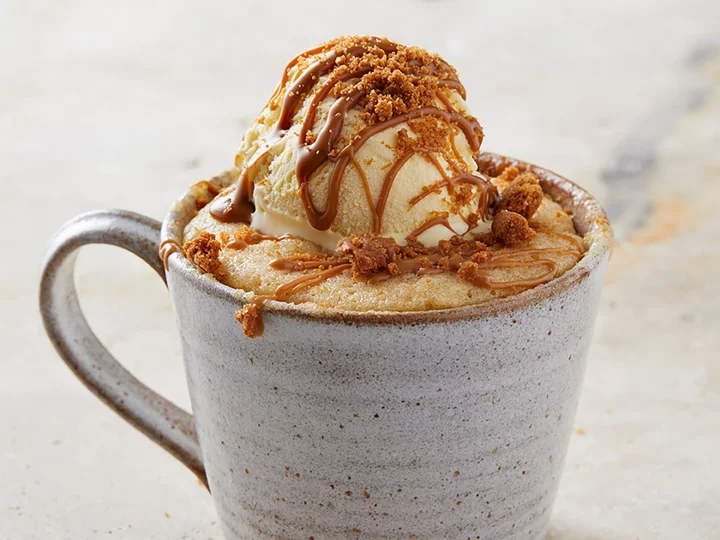
For a quick sugar fix, try this Biscoff microwave mug cake
Microwave cakes will never replace an oven-baked cake, in my opinion, because good things take time to create,” says former Great British Bake Off contestant, Hermine Dossou. “That said, when you don’t have an oven, when you’re not in your own kitchen with your own equipment, when you’re limited by time, or even have just a few bits of ingredients here and there, microwave mug cakes make a great substitute. And they’ll help you get rid of that sugar craving!” Speculoos mug cake Serves: 1 Ingredients: 30g salted butter 1 tsp speculoos spread 40g sugar 25g whole milk 1 small egg 40g self-raising flour 1 tsp vanilla extract For the topping: 1 tbsp speculoos spread 1 scoop vanilla ice cream 1 speculoos or other biscuit, for crumbling Method: 1. Put the butter and speculoos spread in a large mug and microwave on medium–high power (600 watts) for 10-20 seconds. Stir until smooth. 2. Add the sugar and milk and stir until combined. Then add the egg and mix vigorously with a whisk or small spatula to avoid streaks of egg white in your cake. 3. Finally, add the flour and vanilla, mixing thoroughly to ensure there are no lumps. 4. Microwave on medium–high (600 watts) for one minute. Keep an eye on the cake as each microwave cooks differently. You want the batter to be only just cooked; when you lightly touch the top, it should feel slightly sticky. If it feels completely dry, you have overcooked your cake. Remove from the microwave and allow to cool. 5. To serve, melt the one tablespoon of speculoos spread in the microwave for about 10 seconds. Top the cake with a scoop of vanilla ice cream, drizzle with the melted speculoos spread and sprinkle with the crumbled biscuit. Enjoy. ‘The Thrifty Baker’ by Hermine Dossou (White Lion, £18.99).
2023-09-06 13:57
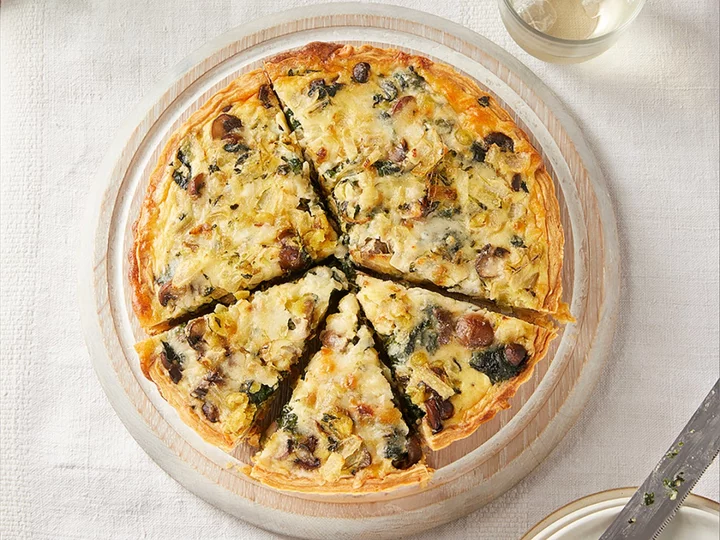
How to make spinach and mushroom quiche
It’s often said that quiche is old-fashioned, but there is nothing old-fashioned about this one,” says former Great British Bake Off contestant Hermine Dossou. “It’s a crumbly, super-short, melt-in-your-mouth pastry filled with buttery spinach and creamy custard. “Gruyère is the perfect cheese for quiche and a little goes a long way, but if it’s not available, you can substitute with Emmental, Comté, Jarlsberg or Beaufort.” Spinach and mushroom quiche Serves: 8 Ingredients: For the shortcrust pastry: 210g plain flour (gf plus 1 tsp xanthan gum), plus extra for dusting 130g cold butter 1 large egg (55g) 1 tbsp cold water ¼ tsp salt For the custard: 15g butterLeaves from 3 thyme sprigs 1 small yellow onion (about 50g), finely chopped 2 eggs 120g double cream 1 chicken or vegetable stock cube, crumbled 1 tsp Dijon mustard ¼ tsp salt Pinch of black pepper For the filling: 30g butter 250g mushrooms, sliced ½ tsp garlic powder A pinch of salt 250g baby spinach leaves 80g grated Gruyére cheese Method: 1. To make the shortcrust pastry, in a large bowl rub the flour and butter together with your fingertips until sandy in texture. (You can use a food processor to speed up this process.) Add the egg, water and salt and bring together into a dough without overworking it. Wrap in cling film and chill in the fridge – you always want to work with cold pastry as it’s much easier to handle. 2. When ready, lightly flour a work surface and roll out the dough to a circle about 30cm in diameter and 3mm thick. Use your rolling pin to lift it up and lay it over a 23cm tart tin, so there is an overhang of pastry at the top. Using a straight-sided glass, ease the pastry into the corners of the tin by rolling the glass around the edge in circular motion. Chill for 20 minutes. 3. Preheat your oven at 200C/180C fan/400F/Gas 6. Line your chilled pastry case with parchment paper, fill it with baking beans or cheap pulses, and blind bake for 15 minutes. Lift out the baking beans and parchment paper and continue baking for a further 10 minutes to dry out the base. 4. Meanwhile, make the custard. Put the butter, thyme and onion in a small frying pan over medium heat and cook until the onion is soft and transparent. Set aside to cool slightly. In a medium bowl, whisk together the eggs, cream, stock cube, mustard, salt and pepper, adding the cooked onions. Set aside. 5. Prepare the filling using the same pan you used to cook the onions. Heat the butter, add the mushrooms, garlic and salt, and cook over a high heat until the mushrooms are soft and most of the water has evaporated. Add the spinach and cook until it has wilted and the mixture is thick. 6. Tip the spinach mixture into the pre-baked tart case and spread it around evenly. Sprinkle over the grated cheese, then pour in the custard, making sure it’s distributed evenly. Bake at 200C/180C fan/400F/Gas 6 for 20–25 minutes, or until the middle of the quiche looks set and the top is slightly golden. Enjoy warm. ‘The Thrifty Baker’ by Hermine Dossou (White Lion, £18.99).
2023-09-06 13:52

Hermine Dossou: Being thrifty in the kitchen helped me get on the housing ladder
As a trained accountant and a long-time baking enthusiast, Hermine Dossou knows a thing or two about saving money in the kitchen. “My first breadmaker was from Panasonic – I bought it from Gumtree,” the former Great British Bake Off contestant says. “It was basically somebody’s wedding present that they didn’t want and they sold it half price.” A devotee of Martin Lewis’s Money Saving Expert website, the 42-year-old, who was born in Benin, West Africa, and moved to the UK for university aged 20, tries to avoid ever paying full price for a big ticket item. “If I wanted to buy, let’s say, a mixer, I would go online, and type ‘Kenwood discount vouchers’ and then something always comes up,” says Dossou, who lives in Kettering and came fourth on the 2020 series of Bake Off. But the mum-of-one – whose son Steven is 13 – wasn’t always such a frugal foodie. “That came from that period where I became a single mum on a reduced income,” she says. “I couldn’t work full-time because I had to look after my son, and also I didn’t want him to have the processed kind of bakes.” Whipping up cakes and cookies filled her “empty afternoons” as a new mum and was a lot cheaper than buying ready-made baked goods. “I would cook from scratch and prep my vegetables when I could get them on offer,” she continues. “Same for fruits – they are often very discounted when they become a bit soft, and that’s the best time to make jam.” Even post-Bake Off and her book deal (she works full-time as an accountant), Dossou remains a savvy shopper, knowing that a higher price doesn’t always mean a better product. “Like a bar of chocolate, if it’s the same quantity of cocoa, why are you paying three times the price? Especially if you’re going to bake with it. “Wonky onions at half the price is the same… they all come from the same farm.” Her accountancy skills came in handy, too, and she still uses a spreadsheet to track her income and outgoings every month. “I think generally in life it is important to budget and know where your money goes, because I think it allows you to achieve a lot more than if you were just living freestyle,” Dossou says. “It’s a nightmare trying to get on the housing ladder here in the UK – that’s something I’ve been able to do through being thrifty in every area of my life.” That’s why she decided to call her first cookbook The Thrifty Baker: “I just really wanted to bring that awareness of how we choose what we eat, and how we can save through making little changes here and there.” “Now, more than ever, when people are struggling with the cost of living, I think it’s even more important to go back to those values of cooking from scratch, trying to cook at home, and making meals from, you know, not much.” With lots of advice for beginners, the book focuses on affordable dishes, from basic breads and simple biscuits to special occasion puds and impressive-looking desserts. There’s a distinct Gallic influence (Benin, where Dossou learned to bake as a child, is a former French colony) felt with recipes such as pain de campagne, orange and brown butter madeleinesm and pear frangipane tart. The author points out when a recipe can be cooked in an air fryer – a recent Black Friday bargain she loves because it allows her to enjoy fried Benin delicacies using less oil and without turning on the oven. “Because we have a really small family, just me and my son, you don’t always want to put the oven on just to bake something for two. “With an oven you’ll need to preheat it for a good 15 to 20 minutes before you can even bake in it. With the air fryer you just put the cake in and 15 minutes later it’s out – easy and convenient.” There’s also a section devoted to microwaveable mug cakes, with peanut butter and jam, speculoos (aka Biscoff) and chocolate hazelnut flavours of the cheap and easy-to-make single-serve puds. “In the microwave you can make a cake in five minutes from weighing, mixing and baking,” says Dossou, who loves how kid-friendly they are. “With my son I feel more inclined to let him make a mug cake than maybe something bigger. “Even if it goes wrong he’s not wasting a lot of ingredients and, you know, he’s not turning the kitchen into a bonfire.” ‘The Thrifty Baker’ by Hermine Dossou (White Lion, £18.99).
2023-09-06 13:45
